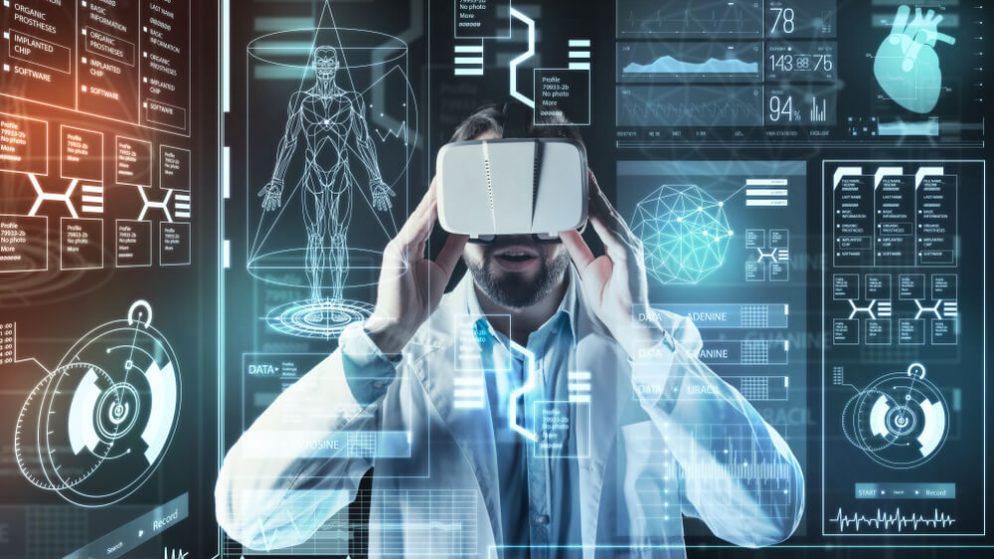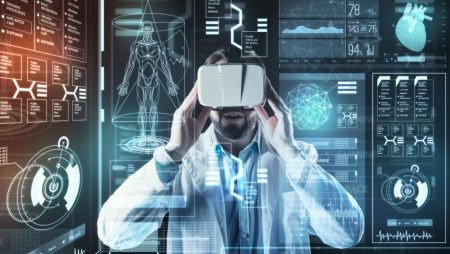



Get new exclusive access to healthcare business reports & breaking news




It’s no surprise that more applications for technological advancements emerge in various fields. In health care and medicine, new technologies can be leveraged to improve patient care, enhance operational efficiency, and assist doctors, surgeons and nurses with their daily tasks.
For example, artificial intelligence (AI) and machine learning (ML) are growing in popularity and applications. Virtual reality (VR) is being used in physical therapy, and the Medical Internet of Things (MIoT) is expanding. The one technology missing? Augmented reality (AR).
AR is one of the latest technological trends at present, and it’s likely to be more prevalent in the future. It’s expected that the market will grow to reach around $340 billion by 2028. Companies and individuals are adopting AR-supported online platforms for various purposes, such as e-commerce, education and social media.
However, it’s worth noting that AR can also be used in a medical setting to improve the quality of patient care. The question is, how?
Here’s more information about augmented reality, its applications in the medical field and what can be expected in the future.
To understand AR, it’s best to examine real-world examples and how ordinary people use it for entertainment purposes. Here’s how AR technology works.
Go back a handful of years ago to 2016 and think of the trending game, “Pokemon Go.” Users ran around different areas of their towns or cities, capturing Pokemon characters on their phones. How did they do it?
The entire “Pokemon Go” game was made possible by using advanced AR technology. Interestingly enough, the hype surrounding the game never went away. 2019 was its most lucrative year so far — it took in $900 million from in-app purchases.
“Pokemon Go” characters could pop up pretty much anywhere, from outside on sidewalks to inside homes. The options were limitless, which made the game the sensation that it is today.
In simple terms, AR modified the reality people see in front of them using digital content. This includes images, sound or text that is usually overlaid with the existing environment.
Even social media platforms like Snapchat, Facebook, Instagram and Pinterest are coming up with new AR features. Snapchat users can use filters, effects and lenses to alter what can be seen in their videos.
There are over 200,000 lens creators, 2 million lenses and 2 trillion lens views, according to Snapchat. This means users are actively engaging with the content AR provides and using the technology for various purposes.
For AR to work, there first needs to be a device equipped with a camera — this could be a smartphone, tablet or even smart glasses. These devices need to be capable of handling AR software.
When the user points their camera to an area, the installed AR software will use computer vision technology to pick up on the environment. The software will then analyze the surrounding context and assess changes when the user moves their camera around.
Once the device captures the environment, it downloads the information about the object from the cloud. It then presents a 3D experience to the user — the surroundings become half digital and half reality. Users are essentially in control of the AR software when they move their camera or touch their screen.
As users move around, the AR display will also move. The size and orientation arrange themselves appropriately to fit the new context of the environment to give users an immersive experience. AR provides a virtual environment for users to enjoy, but there are other applications for this tech.
Here’s how AR can change the fields of health care and medicine.
It’s always a priority to improve patient outcomes through the use of new technologies. AR has a wide range of applications in the health care sector.
Neurosurgeons are using AR to assist with their operations. They can identify enlarged blood vessels running through the brain, which can help surgeons essentially create a map. AR can step in to assist all kinds of doctors, regardless of which body part is being operated on.
AR can be used to study a person’s internal anatomy, such as organs, muscles and bones, without making any incisions. Thus, surgeons can perform low-risk and accurate surgeries without spending as much time as they would have before.
It’s no secret that medical professionals need to go through extensive training before treating patients, whether it’s annual checkups or something as serious as brain surgery.
Using AR to train health care providers is a perfect application. Immersing potential surgeons in real-world scenarios by using AR can help them learn the ins and outs of procedures and gain experience practicing on patients.
Essentially, those being trained use headsets with see-through vision — the tech projects images of the patient’s internal anatomy based on past CT scans.
This helps surgeons prepare for their future practice, but it also is reassuring to patients who worry about their procedures. If they know their doctor is well-trained with new technology, the concerns associated with surgery can be alleviated.
Teleconferencing has grown in popularity due to the COVID-19 pandemic, and doctors can also collaborate during significant surgeries. With the help of AR, they can participate in meetings to address any medical issues a patient is experiencing.
Patients benefit when doctors collaborate effectively. It naturally improves the quality of care given — costs are reduced, outcomes are improved and communication is clearer.
One issue medical providers face on occasion is a patient who cannot adequately describe the symptoms causing them pain or discomfort. People need to accurately describe their symptoms to get the best treatment options. Here is where AR can help.
Patient education is critical for all parties involved in medicine. In other words, taking the time to teach patients about various symptoms will help them when describing them to their doctor. AR apps on the market can show people how different medical conditions or diagnoses can affect them.
Virtual therapy is becoming more prevalent. There’s no sign of it slowing down, thanks to the use of AR tech.
Licensed counselors can use AR during exposure therapy treatment sessions to help patients grow more comfortable with their anxieties, such as phobias. Phobias are powerful and can sometimes take over someone’s life, so AR tech could be revolutionary.
Exposure therapy is used to help patients confront their fears by exposing them. When people are fearful of something, they tend to use avoidance. Take a fear of spiders, for example. If a patient is immersed in an environment with superimposed spiders, they’re participating in exposure therapy.
Doctors can talk to the patient and help treat their fears and anxieties without spiders being in the room. It’s a fascinating use of AR, and it’s likely to be used much more often in therapeutic sessions moving forward.
Anyone who’s ever gone to get bloodwork done knows that sometimes it can be hard to locate a vein for proper insertion. Here is where AccuVein comes in handy — the AR-based device is set to revolutionize the way nurses and doctors draw blood and make injections.
When using AccuVein’s products, medical professionals can engage in vein visualization and essentially see the layout under a patient’s skin to ensure they’re sticking the needle in the correct spot to draw blood or administer injections. AccuVein claims its product is the world’s first handheld device capable of vein illumination.
AR has taken the guesswork out of bloodwork, and both nurses and patients benefit. AccuVein’s device uses projection-based AR to locate veins and combines laser-based scanners, a processing system and digital laser projection. All these technological components are housed in a single device, making it user-friendly and portable.
Researchers have a strong interest in seeing the impact of AR tech on cancer treatment options. In addition to diagnosis, AR tech could alleviate acute and chronic pain resulting from cancer.
For example, some medical professionals are using AR to immerse their patients in enjoyable simulations to distract them from the pain they’re experiencing. This could transform traditional pain management strategies for doctors as they work to improve people’s lives.
While these are only a handful of examples, it’s evident that AR is carving out a place in the medical field. Because it’s ever-changing, there could be more applications shortly. It’ll be interesting to see which technologies become trends and which are here for the long run. It’s clear that the future is bright for AR in the medical field.
It’s critical for health care facilities to be willing to adopt AR technology to elevate their practices and provide the highest quality care possible to the people who need it most. Whether it’s dentistry, therapy or doctors performing surgery in the operating room, AR is set to revolutionize the health care industry.
This article comes from Zac Amos, Editor @ ReHak. You may contact him directly at [email protected]